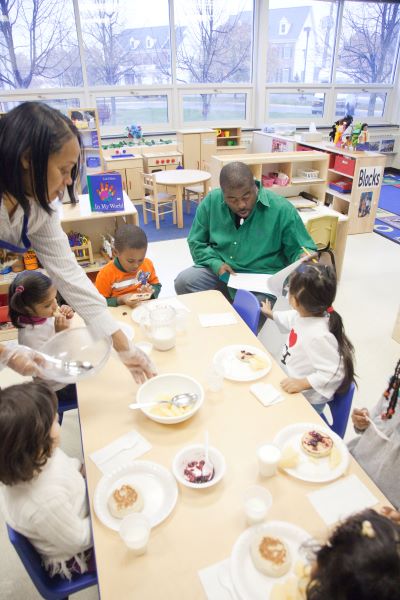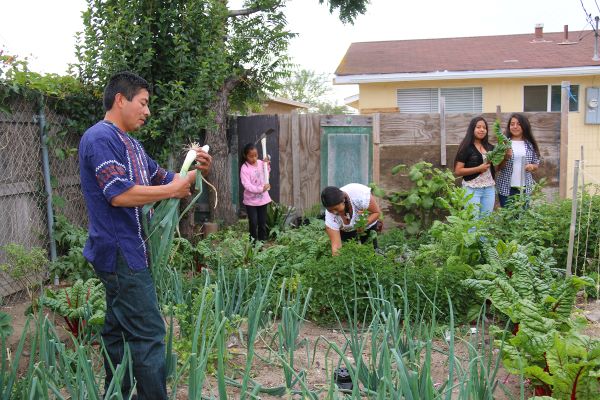 Training staff about nutrition and physical activity raises awareness about the importance of healthy eating and movement on children’s, families’, and staff’s overall health and wellness. The health manager and nutrition professionals can educate staff about children’s nutritional milestones, the importance of physical activity, positive eating environments, and how to prepare nutritious snacks and meals. Staff may also benefit from learning how to engage children during family-style meals, how to speak to families about food security, and how to help families choose and prepare nutritious foods that meet their nutritional and budget needs.
Training staff about nutrition and physical activity raises awareness about the importance of healthy eating and movement on children’s, families’, and staff’s overall health and wellness. The health manager and nutrition professionals can educate staff about children’s nutritional milestones, the importance of physical activity, positive eating environments, and how to prepare nutritious snacks and meals. Staff may also benefit from learning how to engage children during family-style meals, how to speak to families about food security, and how to help families choose and prepare nutritious foods that meet their nutritional and budget needs.
Some key messages to share with staff and families include:
- Offer plenty of vegetables, fruits, and whole-grain products.
- Introduce foods many times since it may take a while for a child to try a new food.
- Include low-fat or nonfat milk or dairy products, including cheese and yogurt.
- Choose lean meats, poultry, fish, lentils, and beans for protein.
- Encourage children and families to drink lots of water.
- Limit high-sugar and saturated-fat foods.
- Limit sugary drinks.
- Offer safe spaces for active play and spend time each day moving and being active.
- Keep babies active with tummy time and time spent out of the swing or bouncy chair.
- Keep toddlers moving by dancing, jumping, and walking together.
- Keep children active by spending time outdoors.
Tips and Strategies for Training Staff
- Find developmentally appropriate nutrition education materials.
- Encourage staff to complete the Moving with the Brain in Mind and Nutrition Building Blocks courses on the Individualized Professional Development (iPD) Portfolio.
- Give families information about nutrition assistance programs.
Resources for Staff Professional Development
- Bright Futures: Nutrition
- Nutrition Education Materials
- Healthy Weight, Nutrition, and Physical Activity
- Choosing Healthy Drinks
- Increasing Access to Drinking Water and Other Healthier Beverages in Early Care and Education Settings
- CACFP Halftime: 30 on Thursdays Training Webinars
- The Institute of Child Nutrition (ICN)
- Harvest for Healthy Kids
Collaborating with Families
Health managers, nutrition consultants or managers, and family engagement staff can support families with information about healthy prenatal and postpartum nutrition as appropriate, including breastfeeding and chestfeeding support.
Food can be a sensitive topic. It’s a good idea to get a feel for a family’s attitudes toward and experiences with food, food security, cooking, and mealtime. Families’ involvement in their child’s healthy eating is key to children’s overall health and well-being. Families who introduce, reinforce, and model healthy eating and physical movement behaviors and attitudes pass them on to their child. You can help families realize the important role that healthy eating and family-style dining play in their child’s physical, behavioral, and emotional well-being. Families also bring a wealth of information too. Look for opportunities to engage with families to share their nutrition knowledge. To best partner with families supporting their children’s healthy eating, carry out strategies that reflect families’ values, culture, and language. Keep in mind what’s important to the family, including the ages of their children, family budget, affordable and accessible neighborhood services, religious preferences, and mealtime habits.
 Information is important, but hands-on activities can be equally if not more instructive. Consider field trips to local farmers markets and grocery stores, community gardening, cooking demonstrations, and gathering recipes from staff and families to make a cookbook. Many families live in neighborhoods where there is limited safe space for outdoor play. Consider hosting active-play events for whole families in the afternoon or evening. This can be a great time to model healthy active living behaviors. These events can also serve healthy snacks or meals.
Information is important, but hands-on activities can be equally if not more instructive. Consider field trips to local farmers markets and grocery stores, community gardening, cooking demonstrations, and gathering recipes from staff and families to make a cookbook. Many families live in neighborhoods where there is limited safe space for outdoor play. Consider hosting active-play events for whole families in the afternoon or evening. This can be a great time to model healthy active living behaviors. These events can also serve healthy snacks or meals.
Resources for Collaborating with Families
- Healthy Eating: Health Tips for Families
- Active Play: Health Tips for Families
- Bottle Feeding Basics
- Tips for Toddler Feeding
- MyPlate.gov Preschoolers
- Healthy Tips for Picky Eaters
- Learn How to Eat Healthy with MyPlate
- Healthy Weight Checklists and Tip Sheet
Read more:
Resource Type: Article
National Centers: Health, Behavioral Health, and Safety
Audience: Directors and Managers
Last Updated: October 31, 2023